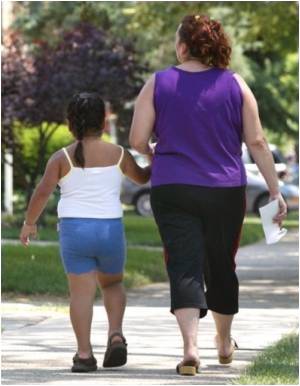The obesity epidemic is raging uncontrolled in US, says a new study, titled, F as in Fat: How Obesity Threatens America's Future 2010.

The report highlights troubling racial, ethnic, regional and income disparities in the nation's obesity epidemic. For instance, adult obesity rates for Blacks and Latinos were higher than for Whites in at least 40 states and the District of Columbia; 10 out of the 11 states with the highest rates of obesity were in the South -- with Mississippi weighing in with highest rates for all adults (33.8 percent) for the sixth year in a row; and 35.3 percent of adults earning less than $15,000 per year were obese compared with 24.5 percent of adults earning $50,000 or more per year.
"Obesity is one of the biggest public health challenges the country has ever faced, and troubling disparities exist based on race, ethnicity, region, and income," said Jeffrey Levi, PhD, executive director of TFAH. "This report shows that the country has taken bold steps to address the obesity crisis in recent years, but the nation's response has yet to fully match the magnitude of the problem. Millions of Americans still face barriers - like the high cost of healthy foods and lack of access to safe places to be physically active - that make healthy choices challenging."
The report also includes obesity rates among youths ages 10-17, and the results of a new poll on childhood obesity conducted by Greenberg Quinlan Rosner Research and American Viewpoint. The poll shows that 80 percent of Americans recognize that childhood obesity is a significant and growing challenge for the country, and 50 percent of Americans believe childhood obesity is such an important issue that we need to invest more to prevent it immediately. The survey also found that 84 percent of parents believe their children are at a healthy weight, but research shows nearly one-third of children and teens are obese or overweight. Obesity rates among youths ages 10-17 from the 2007 National Survey of Children's Health (NSCH) also were included in the 2009 F as in Fat report. Data collection for the next NSCH will begin in 2011. Currently, more than 12 million children and adolescents are considered obese.
"Obesity rates among the current generation of young people are unacceptably high and a very serious problem," said Risa Lavizzo-Mourey, M.D., M.B.A., RWJF president and CEO. "To reverse this national epidemic, we have to make every community a healthy community. Americans are increasingly ready and willing to make that investment."
Additional key findings include:
Advertisement
Rates of adult obesity for Latinos were above 35 percent in two states (North Dakota and Tennessee) and at 30 percent and above in 19 states.
Advertisement
No state had rates of adult obesity above 35 percent for Whites. Only one state-West Virginia-had an adult obesity rate for Whites greater than 30 percent.
The number of states where adult obesity rates exceed 30 percent doubled in the past year, from four to eight --Alabama, Arkansas, Kentucky, Louisiana, Mississippi, Oklahoma, Tennessee and West Virginia.
Northeastern and Western states had the lowest adult obesity rates; Colorado remained the lowest at 19.1 percent.
The report found that the federal government and many states are undertaking a wide range of policy initiatives to address the obesity crisis. Some key findings include that:
At the federal level:
The new health reform law, the Patient Protection and Affordable Care Act of 2010, has the potential to address the obesity epidemic through a number of prevention and wellness provisions, expand coverage to millions of uninsured Americans, and create a reliable funding stream through the creation of the Prevention and Public Health Fund;
Community Transformation grants have the potential to help leverage the success of existing evidence-based disease prevention programs;
President Barack Obama created a White House Task Force on Childhood Obesity, which issued a new national obesity strategy that contained concrete measures and roles for every agency in the federal government; and.
First Lady Michelle Obama launched the "Let's Move" initiative to solve childhood obesity within a generation.
And at the state level:
Twenty states and D.C. set nutritional standards for school lunches, breakfasts and snacks that are stricter than current United States Department of Agriculture requirements. Five years ago, only four states had legislation requiring stricter standards.
Twenty-eight states and D.C. have nutritional standards for competitive foods sold in schools on à la carte lines, in vending machines, in school stores, or through school bake sales. Five years ago, only six states had nutritional standards for competitive foods.
Every state has some form of physical education requirement for schools, but these requirements are often limited, not enforced or do not meet adequate quality standards.
Twenty states have passed requirements for body mass index screenings of children and adolescents or have passed legislation requiring other forms of weight and/or fitness related assessments in schools. Five years ago, only four states had passed screening requirements.
To enhance the prevention of obesity and related diseases, TFAH and RWJF provide a list of recommended actions in the report. Some key policy recommendations include:
Support obesity- and disease-prevention programs through the new health reform law's Prevention and Public Health Fund, which provides $15 billion in mandatory appropriations for public health and prevention programs over the next 10 years.
Align federal policies and legislation with the goals of the forthcoming National Prevention and Health Promotion Strategy. Opportunities to do this can be found through key pieces of federal legislation that are up for reauthorization in the next few years, including the Child Nutrition and WIC Reauthorization Act; the Elementary and Secondary Education Act; and the Surface Transportation Authorization Act.
Expand the commitment to community-based prevention programs initiated under the American Recovery and Reinvestment Act of 2009 through new provisions in the health reform law, such as Community Transformation grants and the National Diabetes Prevention Program.
Continue to invest in research and evaluation on nutrition, physical activity, obesity and obesity-related health outcomes and associated interventions.
Source-Medindia













